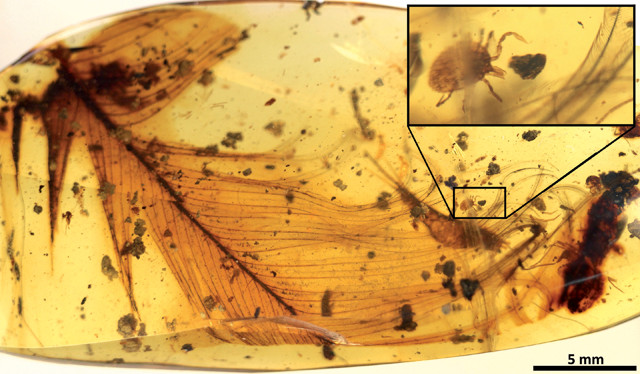
by Mary Caperton Morton Wednesday, March 14, 2018

A tick grasps a dinosaur feather in a piece of 99-million-year-old amber. Credit: E. Peñalver et al., Nature Communications, December 2017.
Blood-sucking, disease-spreading ticks are one of the most maligned parasites in the world, and new evidence shows they’ve been doing their dirty work for a long time: Fossilized ticks dating to the mid-Cretaceous represent the first direct evidence that the ancestors of today’s pesky critters once plagued dinosaurs.
In a new study, published in Nature Communications, Enrique Peñalver from the Spanish Geological Survey and colleagues describe several ticks found preserved in 99-million-year-old Burmese amber, the oldest specimens found to date. One of the ticks represents a previously unknown extinct species named Deinocroton draculi, which means “Dracula’s terrible tick.” Another specimen was found engorged with blood up to eight times its normal size. The find might sound like the setup for a new “Jurassic Park” sequel, but dinosaur DNA has never actually been recovered from amber. “Assessing the composition of the blood meal inside the bloated tick is not feasible because, unfortunately, the tick did not become fully immersed in resin and so its contents were altered by [later] mineral deposition,” said co-author Xavier Delclòs of the University of Barcelona in a statement.
Another tick found entangled in a feather may provide the most direct link to the tick’s last meal: The structure of the feather is similar to those of modern-day birds, but the mid-Cretaceous date for the amber indicates that it likely came from a feathered dinosaur. The ticks add much-needed data to the arachnids’ relatively scarce fossil record. “These findings provide insight into early tick evolution and ecology, and shed light on poorly known arthropod-vertebrate interactions and potential disease transmission during the Mesozoic,” the team wrote.
© 2008-2021. All rights reserved. Any copying, redistribution or retransmission of any of the contents of this service without the expressed written permission of the American Geosciences Institute is expressly prohibited. Click here for all copyright requests.